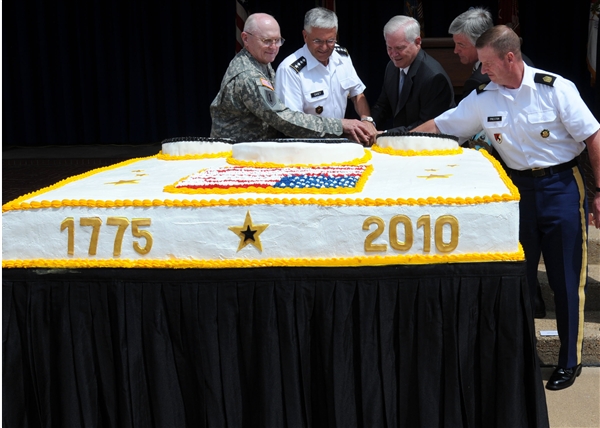WASHINGTON, Jan. 18, 2011 — Two signs stand at the entryway to Farmington, Minn. One displays the city’s population and, just underneath, another sign states “Yellow Ribbon City,” a message to all who that pass by that this city stands for military family support.
These signs are cropping up on city borders and on company walls across the state, thanks to a Minnesota National Guard program that’s bolstering community support of troops and their families.
The Guard’s Beyond the Yellow Ribbon program aims to raise community awareness of the unique wartime challenges military families face and to ensure troops and their families are surrounded by support throughout the deployment process and long after, explained Army Lt. Col. Barbara O’Reilly, the program’s chief.
“They’re very excited to support service members and families,” O’Reilly said of the communities and support organizations in her home state. “They see this is as doing their part and their way to serve and be involved in what we’re doing as a nation.”
The program is an extension of the Defense Department’s Yellow Ribbon Reintegration Program, which offers training events and support to Guard and Reserve service members and their families before, after and during deployment. Beyond the Yellow Ribbon encompasses that training, while also embedding community support and awareness into the process to better serve local troops and their families, explained Army Sgt. 1st Class Melanie Nelson, the program’s chief of communications and marketing.
This support is vital in a state that lacks the resources and extensive support of a major active-duty installation, she said. Yet Minnesota is home to more than 13,000 Guard members, including 11,000 soldiers, about 2,000 airmen, and thousands of other reservists in the Marines, Army, Navy, Air Force and Coast Guard.
Communities are eager to help, Nelson said, and the Guard program can help them understand what the needs are and how they can join forces on behalf of military families.
Communities, such as Farmington, that express a desire to help over the long haul can earn a Yellow Ribbon designation through the Guard program. But this designation doesn’t signify a simple declaration of support by a city official. Instead, Guard officials ask communities or groups to come up with a sustainable action plan on how they’ll support military families throughout the deployment process, Nelson explained.
This plan involves a synchronized effort within the community, including churches, public safety offices, schools, parks and recreation centers and other community resources. A church may host a wonderful event in support of military families, Nelson explained, but could have a much greater impact if it connects with other agencies on behalf of military families.
“The program is about synchronizing the efforts of the community to support service members,” she said. “And it looks different in every community, because every community is different.”
To date, 45 entities –- including counties, companies and cities -– have earned the Yellow Ribbon designation. This number includes 27 cities, 14 companies and four counties, Nelson said.
The first city to sign with a Yellow Ribbon network was Farmington in 2008. The city has become a model for others in the program, O’Reilly said. “This support to military families gave everyone a common thing to work on,” she said.
Within the city, 13 faith-based organizations take turns hosting a military-support effort each month. And, rather than sparsely attended picnics sponsored by each military organization, the city now organizes a communitywide picnic. Last year, the picnic served meals to more than 600 military families, O’Reilly said. “It’s an amazing display of what can happen when you work together,” she said.
The town of Lakeville, another Yellow Ribbon community, united efforts on behalf of families whose loved ones died in combat. Within months, an Army staff sergeant was killed in Iraq and an Air Force major was killed in Afghanistan.
“Lakeville came together as a whole to support the families through the crisis,” Nelson said. The community raised money all summer so it could place a memorial bench in the town’s park in honor of the service members. The community again came together on behalf of a military family when a soldier returned from Afghanistan as a double amputee, Nelson said. “We ask them to make whatever commitment they can make,” she said of the Yellow Ribbon communities. “We’re not telling them they have to do ‘X, Y and Z,’ but to identify to what they can do and commit to doing it.”
An added bonus of this network, she said, is that it’s there for whatever is needed. Nelson cited Hugo, another Yellow Ribbon city, as an example. Just months before it was proclaimed a Yellow Ribbon city, a tornado hit and caused substantial loss within the community. The budding network of community agencies helped the city spring to action quicker in the wake of the natural disaster, she said.
“This idea of a synchronized community makes you better able to react to any type of community-related crisis or event,” Nelson said.
The Guard will be calling on the communities again soon. This spring, the state may see its largest deployment yet, Nelson said. The last time the state faced a large-scale deployment was in 2004, initiating the start of Beyond the Yellow Ribbon.
In 2005, retired Maj. Gen. Larry Shellito, then Minnesota’s adjutant general, tasked the state chaplain to create a program that would ease the homecoming process for returning soldiers. He wanted their homecomings to be far different from the one he received as a second lieutenant after he returned from Vietnam and hid his uniform before he got to the airport, concerned about the reception he’d receive wearing it.
When the soldiers returned in 2006, they did so to a comprehensive reintegration program that helped to ensure a successful transition back to their everyday lives.
To step up support for troops and families during this next deployment, O’Reilly said, they’re calling on unit commanders to administer an assessment so they can take stock of what the actual needs are. Guard officials then will be able to provide communities with a by-region list of actual needs. Families in a farming community, for example, may have different needs than those in a city, she explained.
“We’re excited to see how this moves forward,” O’Reilly said. “We’ll have a clear picture of what the needs are and how communities can help.”
The Guard also has 14 family assistance centers located in communities across the state to assist troops and their families, particularly those who are impacted by deployment. These centers aren’t there to fix the problem, Nelson explained, but to ensure families are directed to the resource or person who can.
Military people are very proud, and typically are hesitant to accept help unless they’re in crisis mode, O’Reilly noted. “It takes time to build the trust of military members and their families,” she said. “We’re hoping to build relationships now, so families know who to turn to for help when needed,” whether it’s with shoveling snow, bringing in crops or helping with home maintenance or child care issues.
“With the work we’re doing now, building relationships, when there’s a need, the relationship will be there,” she said.
Source:
U.S. Department of Defense
Office of the Assistant Secretary of Defense (Public Affairs)

 von
von 
